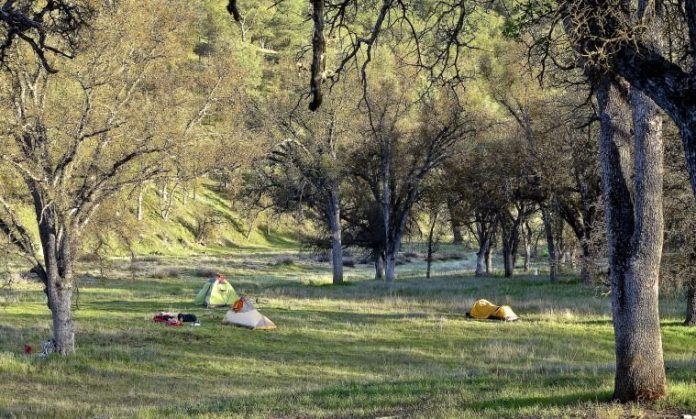I have led visitors on trips into the Orestimba Wilderness deep in the eastern portion of Henry W. Coe State Park on each of the past three weekends. Two trips were overnight backpack outings and the other was a one-day visit. These visits have emphatically reminded me what a lovely place it is.
In fact, “lovely” is a sadly inadequate word to describe the peace and beauty we saw there. I flipped back and forth through my bulky thesaurus until the effort to find a proper adjective caused the volume to started smoking. Nothing in that vast collection of descriptors came close.
Much of the eastern portion of Coe Park relaxes into a gentle landscape so different from the rough deeply corrugated country near the visitor center above Morgan Hill. Rather than a test of strength and endurance, passage through this end of the park is a rolling and restful ramble. We camped on a broad open bench above the wide bed of Orestimba Creek. Evening light cast long shadows and warmed the new yellow-green leafs on the blue oaks. Beneath the oaks, a carpet of green grass and wildflowers rolled with the landscape’s gentle undulations. The day’s last light suffused the scene with a profound peace and beauty that seemed beyond earthly possibilities.
Either the wildflowers ignored the “dry winter” memo or they never got it, for they are here in profusion. Woodland stars, delphiniums, Chinese houses, cream cups, two species of shooting stars, and on and on carpeted the grasslands beneath the blue oaks and gray pines. I even found the delicate and exotic purple mouse ears in surprising numbers. Orestimba Creek flowed timidly, but there were plenty of deep clear pools to tempt a tired hiker. It was enough water to please the turtles, frogs, pollywogs, and fish we saw.
Amid the natural beauty of this remote wilderness there are a few marks left my humans. We passed two large rock outcroppings by the side of the creek. They rose in a broad gentle arc—an inviting spot to sit and linger. Apparently the Yokut Indians who once lived here thought so too. Both rocks have grinding holes left by women who ground acorns here. I could easily imagine them laughing and talking like any group of friends busy with their work.
Up the Rooster Comb Trail, at the foot of the rolling ribbon of rock that gives the geologic feature its name, we looked down into a mine shaft, dug when and for what nobody really knows. Barry Breckling, the retired ranger who spent thirty years at Coe Park, called it the two-second shaft. Drop a rock into it and start counting, and you will understand the name. We peered over the edge of the ever darkening pit…very carefully.
There are several new opportunities for visitors to reach the remote portions of the park along normally closed roads. From there, this amazing landscape is only a comfortable day hike away. The Pine Ridge Association, Coe Park’s interpretive association, has created Coe Outings (www.coepark.org > Programs and Events > Coe Outings), a program of special trips—by bike, horseback, car, or on foot—into the far reaches of the park. In the spring and again in the fall, I lead a one-day outing through Gavilan Community Education. On these trips, the walking begins twelve miles from Bell’s Station on the Pacheco Pass portion of Highway 152.
Finally, the Dowdy Ranch visitor center off Pacheco Pass is now open for day-use on weekends (except April 26-27) throughout the summer. Spring won’t last long. Treat yourself.















